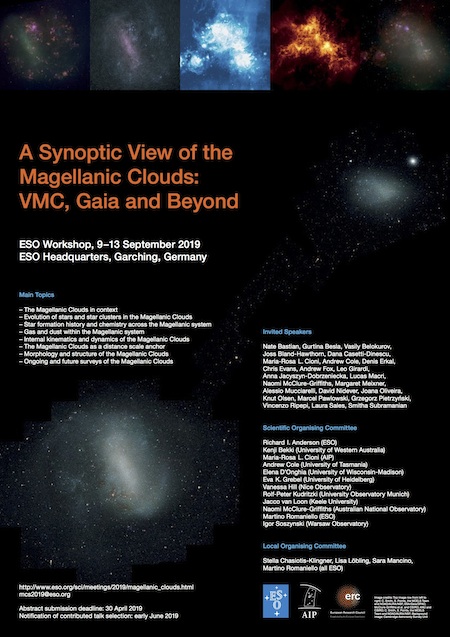ESO, Garching, Germany, 9–13 September 2019
More than 60 years ago, the Magellanic Clouds provided crucial impetus for the construction of large telescopes in the Southern hemisphere and the foundation of ESO. This workshop will provide a fertile forum for shaping the future of research related to the Magellanic Clouds by showcasing state-of-the-art results based on advanced observational programmes as well as discussions of expectations and projections in anticipation of highly multiplexed wide-field spectroscopic surveys (e.g., 4MOST, MOONS) which will come online in the 2020s. This conference also marks the quincentenary of Ferdinand Magellan's arrival in the southern hemisphere during his circumnavigation of the Earth. Very recently, in 2018, there was also Henrietta Leavitt's 150th birthday and the 110th anniversary of her discovery of the period-luminosity relation among Magellanic Cloud Cepheids.
Workshop: A Synoptic View of the Magellanic Clouds - VMC, Gaia and Beyond
The Magellanic Clouds are our nearest example of dwarf galaxies in an early stage of a minor merger event. The distribution of their stars and gas indicate an active history of formation and interaction. Fast forward to today: high-precision time-domain optical (e.g., MACHO, OGLE) and near-infrared surveys (e.g., VMC) covering ever larger areas have now firmly established the Magellanic Clouds as laboratories for variable star astronomy, stellar evolution, stellar populations, and galaxy interactions, as well as anchors of the extragalactic distance scale. Moreover, we are learning increasingly about the Clouds themselves: Cepheids and RR Lyrae stars unravel their three-dimensional structure, and Gaia has recently provided an unprecedented view of the LMC's rotation. For the first time, the community is beginning to link age and metallicity distributions with the kinematics and structure of stellar populations, thereby deciphering the formation and evolution of the Magellanic Clouds in great detail.
Please consult the webpage or e-mail for more information. Registration is now also open.

